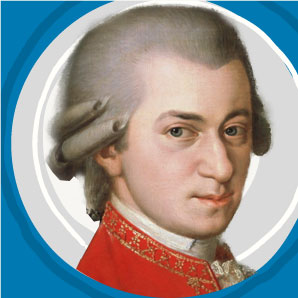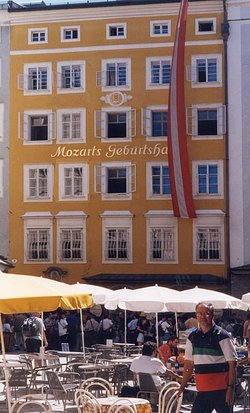Wolfgang Amadeus Mozart - Biography
Wolfgang Amadeus Mozart Biography
Wolfgang Amadeus Mozart (January 27, 1756 – December 5, 1791) was one of the most significant and influential of all composers of Western classical music. His works are loved by many and are frequently performed.
| Contents |
Life
Mozart was born in Salzburg in modern-day Austria, but at the time was the capital of a small independent Archbishopric within the Holy Roman Empire. He was baptized on the day after his birth at St. Rupert's Cathedral as Johannes Chrysostomus Wolfgangus Theophilus Mozart.
The full version of Mozart's name fluctuated considerably during his lifetime; for details, see the article Mozart's name.
The years of travel
Mozart's musical ability started to become apparent when he was a toddler. He was the son of Leopold Mozart, one of Europe's leading musical pedagogues, whose influential textbook Versuch einer gründlichen Violinschule ('Essay on the fundamentals of violin playing') was published in 1756, the same year as Mozart's birth. Mozart received intensive musical training from his father, including instruction in both the piano and violin. Musically, he developed very rapidly and began to compose his own works at the age of five.
Leopold soon realized that he could earn a substantial income by showcasing his son as a Wunderkind in the courts of Europe. Mozart's older sister, Maria Anna, nicknamed 'Nannerl', was a talented pianist and often accompanied her brother on Leopold's tours. Mozart wrote a number of piano pieces, in particular duets and duos, to play with her. On one occasion when Mozart became ill, Leopold expressed more concern over the loss of income than over Mozart's well-being. Constant travel and cold weather may have contributed to his subsequent illness later in life.
During his formative years, Mozart completed several journeys throughout Europe, beginning with an exhibition in 1762 at the Court of the Prince of Bavaria in Munich, then in the same year at the Imperial Court in Vienna. A long concert tour soon followed, (three and a half years) which took him with his father to the courts of Munich, Mannheim, Paris, London, The Hague, again to Paris, and back home via Zurich, Donaueschingen, and Munich. They went to Vienna again in late 1767 and remained there until December 1768.
After one year spent in Salzburg, three trips to Italy followed: From December 1769 to March 1771, August to December 1771, and October 1772 to March 1773. During the first of these trips, Mozart met G.B. Martini in Bologna, and was accepted as a member of the famous Accademia Filarmonica. A highlight of the Italian journey, which is now an almost legendary tale, occurred when he heard Gregorio Allegri's Miserere once in performance, then wrote it out in its entirety from memory, only returning a second time to correct minor errors.
In September of 1777, accompanied only by his mother, Mozart began a tour of Europe that included Munich, Mannheim, and Paris, where she died.
During his trips, Mozart met a great number of musicians and acquainted himself with the works of other great composers: Amongst them were J.S. Bach, G.F. Handel, and Joseph Haydn. Even non-musicians caught his attention: He was so taken by the sound created by Benjamin Franklin's glass harmonica, he composed several pieces of music for it.
Mozart in Vienna
In 1781, Mozart visited Vienna in the company of his employer, the harsh Prince-Archbishop Colloredo, and had a falling out with him. According to Mozart's own testimony, he was dismissed literally 'with a kick in the seat of the pants.' Despite this, Mozart chose to settle and develop his career in Vienna after its aristocracy began to take an interest in him.
On August 4, 1782, he married Constanze Weber against his father's wishes. He and Constanze had six children, of whom only two survived infancy. Neither of these two, Karl Thomas (1784–1858) or Franz Xaver Wolfgang (1791–1844), married or had children.
1782 was an auspicious year for Mozart's career; his opera The Abduction from the Seraglio was a great success, and he began a series of concerts at which he premiered his own piano concertos as conductor and soloist.
As an adult, Mozart became a Freemason and worked fervently and successfully to convert his father before his death in 1787. His late opera The Magic Flute includes Masonic themes and allegory. He was in the same Masonic Lodge as Joseph Haydn.
Mozart's life was fraught with financial difficulty and illness. Often, he received no payment for his work, and what sums he did receive were quickly consumed by his extravagant lifestyle.
Mozart spent the year 1786 in Vienna in an apartment which may be visited today at Domgasse 5 behind St. Stephen's Cathedral; it was here that Mozart composed Le nozze di Figaro in 1786.
Final illness and death
Mozart's final illness and death are difficult scholarly topics, obscured by Romantic legends and replete with conflicting theories. Scholars disagree about the course of decline in Mozart's health--particularly at what point Mozart became aware of his impending death, and whether this awareness influenced his final works. The Romantic view holds that Mozart declined gradually, and that his outlook and compositions paralleled this decline. In opposition to this, some contemporary scholarship points out correspondence from Mozart's final year indicating that he was in good cheer, as well as evidence that Mozart's death was sudden and a shock to his family and friends.
The actual cause of Mozart's death is also a matter of conjecture. His death record listed 'hitziges Frieselfieber' ('severe miliary fever'), a description that does not suffice to identify the cause as it would be diagnosed in modern medicine. In fact, dozens of theories have been proposed, which include trichinosis, mercury poisoning, and rheumatic fever. The contemporary practice of bleeding medical patients is also cited as a contributing clause.
Mozart's death occurred while he was working on his final composition, the Requiem.
According to popular legend, Mozart was penniless and forgotten when he died, and was buried in a pauper's grave. In fact, though he was no longer as fashionable in Vienna as he had once been, he continued to have a well paid job at court and receive substantial commissions from more distant parts of Europe, Prague in particular. Many of his begging letters survive, but they are evidence not so much of poverty than his ability to always spend more than he earned. He was not buried in a mass grave but a regular communal grave according to the 1783 laws.
In 1809, Constanze married Danish diplomat Georg Nikolaus von Nissen (1761–1826). Being a fanatic of Mozart, he edited vulgar passages out of many of the composer's letters and wrote a Mozart biography.
Works, musical style and innovations
- See also: Musical works of Mozart.
Mozart was a prolific composer and wrote for many genres. Among his best works are his operas, the piano concertos, his symphonies, string quartets and string quintets. Mozart also wrote voluminously for solo piano, chamber music, masses and other religious music, dances, divertimenti, and other forms of light entertainment.
Influence
Many important composers since Mozart's time have worshipped or been in awe of Mozart. Beethoven told his pupil Ries that he (Beethoven) would never be able to think of a melody as great as that of the first movement of Mozart's Piano concerto No. 24, and paid homage to Mozart by writing variations on several of his themes; for example, the two sets of Variations for Cello and Piano on themes from Mozart's Magic Flute, and cadenzas to several of the Mozart's piano concertos, most notably the Piano concerto No. 20 K. 466. After the only meeting between the two composers, Mozart noted that Beethoven would 'give the world something to talk about.' As well, Tchaikovsky wrote his Mozartiana in praise of him; Mahler died with the word 'Mozart' on his lips.
The Köchel catalog
In the decades following Mozart's death there were several attempts to catalog his compositions, but was not until 1862 that Ludwig von Köchel, a Viennese botanist, mineralogist, and educator, succeeded in this enterprise. Köchel's book of 551 pages was entitled Chronological-Thematic Catalogue of the Complete Musical Works of WOLFGANG AMADE MOZART. The prefix K or KV which accompanies catalog numbers assigned to Mozart's works, instead of Opus, are derivative of Köchel's name. Köchel catalog numbers not only attempt to establish chronology, but also give a helpful shorthand to refer to Mozart's works. Many of his famous works are referred to now by only their Köchel catalog number; for example, the Piano concerto in A major is often referred to simply as 'K. 488.'
In 1937, Alfred Einstein published a corrected and expanded edition of the Köchel catalog. The next revised edition of the catalog was published in 1964; this version is most commonly in use today. A new revision of the catalog is in preparation.
The Myth of Mozart
Mozart is unusual among composers for being the subject of many legends and myths. An example is the story that Mozart composed his Requiem with the belief it was for himself. Some of these myths may be based in fact, but sorting out fabrications from real events is a vexing and continuous task for Mozart scholars. Dramatists and screenwriters, free from responsibilities of scholarship, have found excellent material amongst these legends.
An especially popular case is the supposed rivalry between Mozart and Antonio Salieri; this is the subject of Aleksandr Pushkin's play Mozart and Salieri, Nicolai Rimsky-Korsakov's opera Mozart et Salieri, and Peter Shaffer's play Amadeus; the last of these has been made into a feature-length film of the same name. In fact, Salieri admired Mozart. Shaffer's play attracted criticism for portraying Mozart as vulgar and loutish, a characterization felt by many to be unfairly exaggerated. Indeed, Salieri does very well out of the play and even better out of the magnificent portrayal of himself by F. Murray Abraham in the film of the play. Most people hadn't heard of him. The attendent at the cemetery where Mozart's memorial lies responded 'Who?' when asked 'What about Salieri, where is he buried?'
See also: 1 (http://www.geocities.com/ ).
Media
Downloadable music by Mozart (ogg format)
- Rondo Alla Turca, from Piano Sonata No. 11
- K545 - Allegro from Piano Sonata in C major
- K545 - Andante from Piano Sonata in C major
- K545 - Rondo from Piano Sonata in C major
See also
- Category:Mozart compositions
- List of compositions by Mozart, which directly links to several Wikipedia articles about separate compositions by Mozart.
- Mozart's name
- Mozartkugel, a sweet named in his honor.
- Mozart effect, a disputed theory that certain kinds of music enhance performance on certain mental tasks; the researchers who coined the term used a Mozart piece in their first study.
Further reading
- Aloys Greither: Wolfgang Amade' Mozart Rowohlt Taschenbuch Verlag GmbH, 1962
- Robert W. Gutman: Mozart: A Cultural Biography. Random, 2001 ISBN 015100482X
- H. C. Robbins Landon: 1791: Mozart's Last Year. Thames & Hudson, 1988 ISBN 0500281076
- Massimo Mila: Lettura delle Nozze di Figaro, Einaudi, 1979, ISBN 8806189379
- Stanley Sadie, ed.: Mozart and His Operas. St. Martin's, 2000 ISBN 031224410X
- Maynard Solomon: Mozart: a life. Harper, 1996 ISBN 0060926929
- Hershel Jick: A Listener's Guide to Mozart's Music Vantage, 1997 ISBN 0553123089
External links
This biography is published under the GNU Licence





